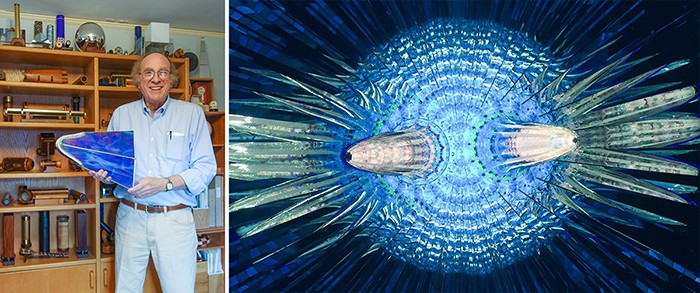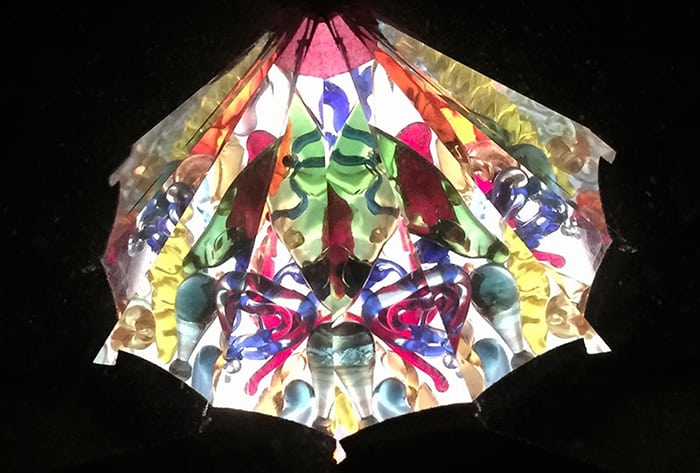Two centuries after the kaleidoscope was invented, Robert P Crease stumbles into an incredible world as he visits a physicist who collects these and other “philosophical toys”

“This,” said Kenneth Brecher, handing me an ordinary cardboard kaleidoscope, “was the first mass-market fad – the first hula hoop, the first Rubik’s cube! It was a popular 19th-century science sensation with a huge impact on optical devices that followed, right up to the development of cinema.”
Brecher, a tall, reddish-haired, animated man of 71, was standing in the dining room of his home in the outskirts of Boston. He has put in 43 years as a professor of physics and astronomy at the Massachusetts Institute of Technology and at Boston University; he and his wife – also a physicist – have an asteroid named after them (4242 Brecher). He also researches visual perception and science education. All these interests intersect in kaleidoscopes; Brecher is surely the only kaleidoscope collector thoroughly versed in the physics and visual psychology principles on which they are based.
I had come to visit him in a commemorative mode: not only is 2015 the bicentenary of the idea behind kaleidoscopes, it is also the International Year of Light (IYL 2015), to which kaleidoscopes, and Brecher’s own research, have surprising connections. His house was teeming with spectra produced by light from the morning Sun that struck prisms in each room. On the dining-room table, he had laid out for my benefit a dozen kaleidoscopes that were special, either historically or technologically, drawn from his collection of 150 or so mostly displayed in a room on the floor above. “Upstairs we’ll play,” he said. “Here we learn!” The history of kaleidoscopes, I was about to discover, is a tangled saga of intersecting technologies, social developments, mathematical principles and singular personalities.
How kaleidoscopes began
The kaleidoscope Brecher handed me was the ordinary sort I had as a kid. Its basic elements are two angled mirrors, a mounting tube and an object case at one end of the tube containing a collection of objects. Peering through the kaleidoscope – the first I’d looked through in decades – I saw a mosaic of six colourful images sprouting symmetrically from a centre point. Turning the object case jostled the objects inside, magically morphing the stained-glass-like mosaic while still preserving its symmetry.
The man who invented and named the kaleidoscope was David Brewster (1781–1868). Brewster graduated from the University of Edinburgh in 1800 heading towards a career as a minister, but a case of stage fright paralysed him during his first sermon, causing him to leave the pulpit and the vocation. Brewster instead became an entrepreneur and man of letters, writing a biography of Isaac Newton among other activities. “See this?” Brecher said, holding up a cigar-box lid decorated with a distinguished portrait. “That’s him!”
Brewster also became a serious amateur scientist in the days when that was possible. Intrigued by optical phenomena such as reflection and refraction, he made a tremendous discovery. “Remember the Brewster angle?” Brecher asked. I did; it’s the angle at which unpolarized light striking an object creates a reflected beam that’s polarized. Brewster’s discovery in 1814 brought him Royal Society membership and the Copley Medal. “Polarization through reflection – that’s what’s behind the gas laser,” said Brecher.
The next year, 1815, Brewster noticed that two mirrors placed at certain angles create a curious multiplication of images and succession of “splendid colours” that is “one of the most beautiful [phenomena] in optics”. Further toying let him make symmetrical images of the reflections, and he enhanced their beauty by putting small pieces of coloured glass in a transparent container at the far end of the mirrors. Brewster patented the device in 1817, and tried to mass-market it with the help of a manufacturer. He coined the term kaleidoscope by combining the Greek words kalos (beauty), eidos (form) and scopein (to see).
In 1818 Brewster wrote of his invention in The Kaleidoscope: Its History, Theory and Construction, with Its Application to the Fine and Useful Arts. The fundamental principle of the kaleidoscope, Brewster wrote, is “that it produces symmetrical and beautiful pictures, by converting simple into compound or beautiful forms, and arranging them, by successive reflexions, into one perfect whole”. The sensational appeal of this device swept across all social strata in Britain and abroad. “It afforded delight to the poor as well as the rich; to the old as well as the young…200,000 instruments were sold in London and Paris during three months.”
Novel, inexpensive and beautiful, kaleidoscopes inevitably attracted knock-offs. “It was like Samsung and Apple,” Brecher said, drawing comparisons with today’s mobile-phone wars. “Rivals made small variants or exploited defects in the original patent application, and Brewster got screwed – never made a buck.” Brewster fought patent infringers, unsuccessfully, for the rest of his life, and in 1858 published a second, expanded version of his book in which he wrote in extensive detail about his path to discovering the kaleidoscope.
Brewster called his invention a “philosophical instrument” – an entertaining and educational device based on scientific principles – but he also claimed the kaleidoscope would find applications in the “fine and useful arts”, providing artists with beautiful forms that could not be produced other ways. It remained, though, largely a parlour amusement, and was followed throughout the rest of the 19th century by a series of other entertainment devices, such as the stereoscope, praxinoscope, the zoetrope, the phenakistoscope, and the thaumatrope. “The kaleidoscope was the first of a line of optical technologies that culminated in cinema,” Brecher said.

I asked Brecher how he first got interested in kaleidoscopes. As a physicist, he’s studied light and optics since his teenage years, but in 1999 his interest took a different turn when he won a grant from the US National Science Foundation to develop optics-based physics experiments for a hands-on education initiative called Project LITE (Light Inquiry Through Experiments, http://lite.bu.edu). The equipment needed to be cheap, accessible, educational and fun, which led him to also investigate things like visual perception, depth perception and binocular vision.
Brecher was particularly interested in spectroscopes – as he likes to say: “In astronomy, a picture may be worth a thousand words, but a spectrum is worth a thousand pictures.” What Brecher really wanted to do was to create a simple binocular spectroscope that students might find easier to use and would let them view spectra with two eyes. But in 2000, while attending an American Astronomical Society meeting, Brecher stumbled into a store in Albuquerque that had a few kaleidoscopes. “I bought one,” he said. “Paid $50 – a lot of money for a professor! Intriguing, maybe even educational. Also, I thought, if there were a binocular kaleidoscope, it might help me solve the optics problem to build a simple and inexpensive binocular spectroscope.”
But did binocular kaleidoscopes exist?
Introducing Cozy Baker
Nobody knew. But then Brecher learned of an amateur collector named Cozy Baker, who lived outside Washington, DC. The next time Brecher was in the area, for an astronomy review panel at NASA’s Goddard Space Flight Center, he dropped in for a visit.
“It blew my mind!” Brecher said. “She had a thousand kaleidoscopes, in every size and type, all over the house, in every room. I had never seen such a private collection of anything!”
Baker (1923–2010) had a fascinating story herself. In 1981 her 23-year-old son had been killed by a drunk driver. Devastated, she wrote a book about her loss, and on a visit to Nashville, Tennessee, to talk about it she came across a crafts shop that had a handmade kaleidoscope. Baker bought it, and on the plane home pointed it through the window. According to her obituary in the Washington Post, “As Mrs Baker watched the Earth below her melt away in a swirl of crystallized colours, she found the pain of her son’s loss was relieved with every twist of the kaleidoscope.”
Baker began to collect kaleidoscopes, and eventually acquired more than 1000, in what was believed to be the largest such collection in the world. They were made of everything from cardboard and plastic to sharkskin and elephant tusks, and in the shape of everything from simple tubes to aeroplanes and famous buildings. One had cost her $12,000, another was 2m high and 4m long. Her house had an indoor “kaleidoquarium” fish tank and a backyard “kaleidopool”.
Baker became the hub of a network of kaleidoscope designers, makers, collectors and store-owners. She started an organization, the Brewster Kaleidoscope Society, published a journal, hosted annual conferences on kaleidoscopes, and published a series of coffee-table books that promoted kaleidoscopes and the people who made them. “Cozy”, as everyone called her, created a community of kaleidoscope lovers that drew in and educated people who otherwise would have had no interest in the subject. Including Brecher.
“So that’s the rational story of how I got into kaleidoscopes,” he said, “through cheap optics, vision and spectroscopy. The left brain story. Of course, the right brain story is that kaleidoscopes are beautiful and I enjoy them!”
Towards gravity’s rainbow
Thanks to Baker, Brecher found the answer to his original question – true binocular kaleidoscopes do not exist. Baker’s collection did include one with two eyepieces, but it did not combine the vision to create a fusable image. Still, certain of her kaleidoscopes did raise new issues about his other interests in visual perception.
Brecher handed me a glass pyramidal kaleidoscope about 50cm high. Peering through the base, I was startled to see that the mosaic was not flat but spherical. “You don’t need two eyes to have depth perception!” he said triumphantly. “Here you have only monocular cues, but what you are looking at is clearly 3D!” Such devices stimulated him into trying to understand how you can perceive depth from a single monocular image.
Depth perception with one eye is possible because we normally use about a dozen monocular cues to perceive depth (including obscuration, perspective and relative size) but only one binocular cue – the image disparity between the two eyes. “If you help the brain think it is essentially looking through a window at the real world as opposed to a painting or other construct,” Brecher said, “then by using many monocular cues, the percept can seem very 3D.”
In kaleidoscopes, this is usually done by using three or more mirrors, and cutting them off at various angles. “Up to now we’ve been looking at plain vanilla kaleidoscopes,” Brecher explained. “Two mirrors, jointed. But why use just two mirrors? Why not three or more? At various angles?” Intriguingly, the first person to explore the mathematics of polyhedral kaleidoscopes was the German mathematician August Möbius (1790–1868), of Möbius strip fame; the subject was then generalized into a study of n-dimensional kaleidoscopes by the Canadian geometer Harold Coxeter (1907–2003). Three tapered mirrors, it turns out, create a sphere. More can make the image of almost any polygon.
Brecher pulled out an elaborate polyhedral kaleidoscope, looking something like a purple dorsal fin of a shark. The eyepiece was in the end that would be attached to the shark’s body, while the object case was bent around what would be the tip of the fin. “It’s the only one in existence, and I named it,” he said. “Don’t drop it.” I looked in and saw a spectacular blue and white sphere from which two finger-like protrusions seemed to grow, along which other objects seemed to travel when you moved the device.
“Isn’t that amazing!” Brecher said. “This is about as visually complex as you can get. There is no such object in there, after all. But you see it from monocular cues – you can even photograph it!” David Sugich, the designer, asked him to come up with a name. “I said ‘Gravity’s Rainbow’, because those fingers reminded me of gravitational wells. It’s a polyhedral kaleidoscope with four mirrors and a curved endcap.”
Back in fashion
When Baker began collecting in the 1980s, kaleidoscopes were going through a period of relative popularity dubbed the “kaleidoscope renaissance” (the title of a book she wrote in 1993). The resurgence in interest was partly social, triggered by a budding arts and crafts movement and an enthusiasm for psychedelic images. But two technological developments also gave kaleidoscopes an oomph by dramatically boosting the quality of image in them.

The first development involved the use of “front-surface” mirrors. Traditional kaleidoscopes had used ordinary “back-surfaced” mirrors, in which the silvering (or aluminization) is on the back. Such mirrors aren’t ideal for kaleidoscopes because the light gets reflected so often in the device that each time the image gets dimmer. Front-surface mirrors are better because the glass is used only as the matrix to support an aluminized upper surface. The only snag is that if you touch a front-surface mirror even once you ruin it, which is why good kaleidoscopes have to be sealed up. “You’ve got to keep them clean,” Brecher explained.
Another reason for the kaleidoscope renaissance was the use of polarizing sheets, which dramatically improved colour quality in polarized kaleidoscopes. In fact, the idea of using polarized light in kaleidoscopes to create beautiful effects had first been proposed by Brewster in the 1858 edition of his book, in which he suggested incorporating into the eyepiece polarizing crystals known as “herapathite”. Interestingly, a way of creating polarizing sheets from herapathite had to wait until the 1920s and the work of the chemist Edwin Land, who’d originally read Brewster’s book as a teenager and founded what would become the Polaroid Corporation. “There’s a direct line from the kaleidoscope to polarizing transmission materials to Polaroid – then back to the kaleidoscope!” Brecher declared.
Brecher then picked up another kaleidoscope from the table and handed it to me. On the side it read “Judith Karelitz” and “Museum of Modern Art” (referring to MOMA in New York). I looked through it. The mosaic was not symmetrical, but – unusually – in the shape of a spiral. “I don’t know if Karelitz was the first to use polarizing sheets in kaleidoscopes,” said Brecher, “but she was the first to promote them commercially in a big way, through an arrangement with MOMA in the 1970s. By the way you can’t get colours and sharpness like this from a computer screen, at least not yet! The reality is so beautiful!”
The critical point
“Enough pedagogy! Let’s go play!” Brecher led me to the upstairs room where he displays the bulk of his kaleidoscopes. He spent the next hour or so explaining the variants in his collection “Here’s a teleidoscope. They were also invented in the 19th century. What’s distinctive about them is that they have no object case; the object case is the world.” He handed me another. “This is a polariscope. It has two polarizers perpendicular to each other, and incorporates clear transparent materials that are birefringent. Amazing colours!” He showed me a cubic device called a holoscope, developed by the artist Gary Allison, that one views through an open corner; depending on the mirror topology you can create 3D figures based on the five Platonic solids.
I saw others too, including a “Bubble Scope”, which lights up at the press of a button. Its colours are created not by polarization or diffraction, but by interference thanks to a thin film whose thickness changes as you tilt it. Then there was the “Cumos”. Invented by a Japanese teenager named Minori Yamazaki, it’s a cube with six flat mirrors inside, with something painted on one surface, and a small hole cut in one corner as a viewer. There were others too, with different numbers of mirrors, different geometries, different mounts and cases – some made with discs and wheels, some tilted or straight, others barrel- or oblong-shaped. Some object cases are even filled with liquid so the objects move more slowly.
Brecher also showed me a few kaleidoscopes that had been elaborately reconstructed by craftsmen he knew, who were copying instruments that sold at Sotheby’s and Christy’s for as much as $75,000. “Not my world!” Brecher said. “I couldn’t afford an original.” One, a “Parascope” designed by Wiley Jobe, allows you to change the mirror angle, thereby altering the symmetry of the parasol-like image.
As I left, I noticed a psychedelic painting on the wall created by a psychedelic artist who designed the video screen in the largest kaleidoscope in the world – the 20m-high Kaatskill Kaleidoscope in Tremper, New York. It was built in a grain silo and opened in 1996; visitors lie on the ground and look up to see the images. It’s “the first cathedral of the third millennium”, according to the artist, Isaac Abrams. “He was a childhood friend of mine,” said Brecher. “He never took a painting lesson, took LSD one day, and started painting the next day after that and never looked back.”
“One more thing,” Brecher added while I was at the door, producing a binocular-like object. “It’s my version of a binocular teleidoscope.” I looked through, but couldn’t quite resolve the images. “It takes a bit of futzing, and still needs work. Every little bit has to be just right. When I get it right, hopefully everyone will buy it and it will be the next hula hoop!”



